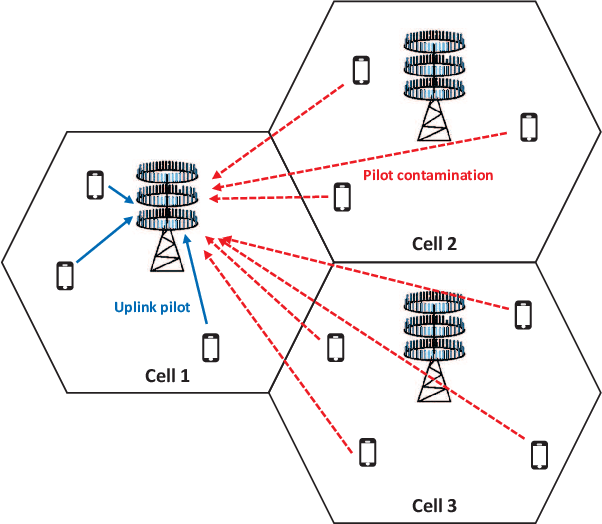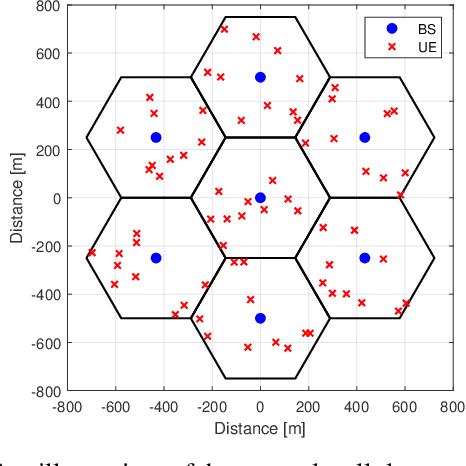Byungju Lim
Graph Neural Network Based Beamforming and RIS Reflection Design in A Multi-RIS Assisted Wireless Network
Jan 24, 2025Abstract:We propose a graph neural network (GNN) architecture to optimize base station (BS) beamforming and reconfigurable intelligent surface (RIS) phase shifts in a multi-RIS assisted wireless network. We create a bipartite graph model to represent a network with multi-RIS, then construct the GNN architecture by exploiting channel information as node and edge features. We employ a message passing mechanism to enable information exchange between RIS nodes and user nodes and facilitate the inference of interference. Each node also maintains a representation vector which can be mapped to the BS beamforming or RIS phase shifts output. Message generation and update of the representation vector at each node are performed using two unsupervised neural networks, which are trained off-line and then used on all nodes of the same type. Simulation results demonstrate that the proposed GNN architecture provides strong scalability with network size, generalizes to different settings, and significantly outperforms conventional algorithms.
Multi-Agent Q-Learning for Real-Time Load Balancing User Association and Handover in Mobile Networks
Dec 22, 2024



Abstract:As next generation cellular networks become denser, associating users with the optimal base stations at each time while ensuring no base station is overloaded becomes critical for achieving stable and high network performance. We propose multi-agent online Q-learning (QL) algorithms for performing real-time load balancing user association and handover in dense cellular networks. The load balancing constraints at all base stations couple the actions of user agents, and we propose two multi-agent action selection policies, one centralized and one distributed, to satisfy load balancing at every learning step. In the centralized policy, the actions of UEs are determined by a central load balancer (CLB) running an algorithm based on swapping the worst connection to maximize the total learning reward. In the distributed policy, each UE takes an action based on its local information by participating in a distributed matching game with the BSs to maximize the local reward. We then integrate these action selection policies into an online QL algorithm that adapts in real-time to network dynamics including channel variations and user mobility, using a reward function that considers a handover cost to reduce handover frequency. The proposed multi-agent QL algorithm features low-complexity and fast convergence, outperforming 3GPP max-SINR association. Both policies adapt well to network dynamics at various UE speed profiles from walking, running, to biking and suburban driving, illustrating their robustness and real-time adaptability.
Joint Pilot Design and Channel Estimation using Deep Residual Learning for Multi-Cell Massive MIMO under Hardware Impairments
Aug 10, 2021



Abstract:In multi-cell massive MIMO systems, channel estimation is deteriorated by pilot contamination and the effects of pilot contamination become more severe due to hardware impairments. In this paper, we propose a joint pilot design and channel estimation based on deep residual learning in order to mitigate the effects of pilot contamination under the consideration of hardware impairments. We first investigate a conventional linear minimum mean square error (LMMSE) based channel estimator to suppress the interference caused by pilot contamination. After that, a deep learning based pilot design is proposed to minimize the mean square error (MSE) of LMMSE channel estimation, which is utilized to the joint pilot design and channel estimator for transfer learning approach. For the channel estimator, we use a deep residual learning which extracts the features of interference caused by pilot contamination and eliminates them to estimate the channel information. Simulation results demonstrate that the proposed joint pilot design and channel estimator outperforms the conventional approach in multi-cell massive MIMO scenarios. Furthermore, the joint pilot design and channel estimator using transfer learning enhances the estimation performance by reducing the effects of pilot contamination when the prior knowledge of pilot contamination cannot be exploited.
Joint Association and Resource Allocation for Multi-Hop Integrated Access and Backhaul (IAB) Network
Aug 10, 2021



Abstract:Integrated access and backhaul (IAB) network is envisioned as a novel network architecture for increasing the network capacity and coverage. To facilitate the IAB network, the appropriate methods of wireless link association and resource management are required. In this paper, we investigate the joint optimization problem of association and resource allocation in terms of subchannel and power for IAB network. In particular, we handle the association and resource allocation problems for wireless backhaul and access links considering multi-hop backhauling. Since the optimization problem for IAB network is formulated as a mixed integer non-linear programming (MINLP), we divide it into three subproblems for association, subchannel allocation, and power allocation, respectively, and these subproblems are solved alternatively to obtain a local optimal solution. For the association problem, we adopt the Lagrangian duality approach to configure the backhaul and access links and successive convex approximation (SCA) approach is used to solve the subchannel and power allocation problems efficiently. Simulation results demonstrate that the proposed algorithm achieves better performance than single-hop backhauling based network and enhances the capacity and coverage by configuring the multi-hop backhauling.
Attention-based Reinforcement Learning for Real-Time UAV Semantic Communication
May 22, 2021



Abstract:In this article, we study the problem of air-to-ground ultra-reliable and low-latency communication (URLLC) for a moving ground user. This is done by controlling multiple unmanned aerial vehicles (UAVs) in real time while avoiding inter-UAV collisions. To this end, we propose a novel multi-agent deep reinforcement learning (MADRL) framework, coined a graph attention exchange network (GAXNet). In GAXNet, each UAV constructs an attention graph locally measuring the level of attention to its neighboring UAVs, while exchanging the attention weights with other UAVs so as to reduce the attention mismatch between them. Simulation results corroborates that GAXNet achieves up to 4.5x higher rewards during training. At execution, without incurring inter-UAV collisions, GAXNet achieves 6.5x lower latency with the target 0.0000001 error rate, compared to a state-of-the-art baseline framework.
 Add to Chrome
Add to Chrome Add to Firefox
Add to Firefox Add to Edge
Add to Edge